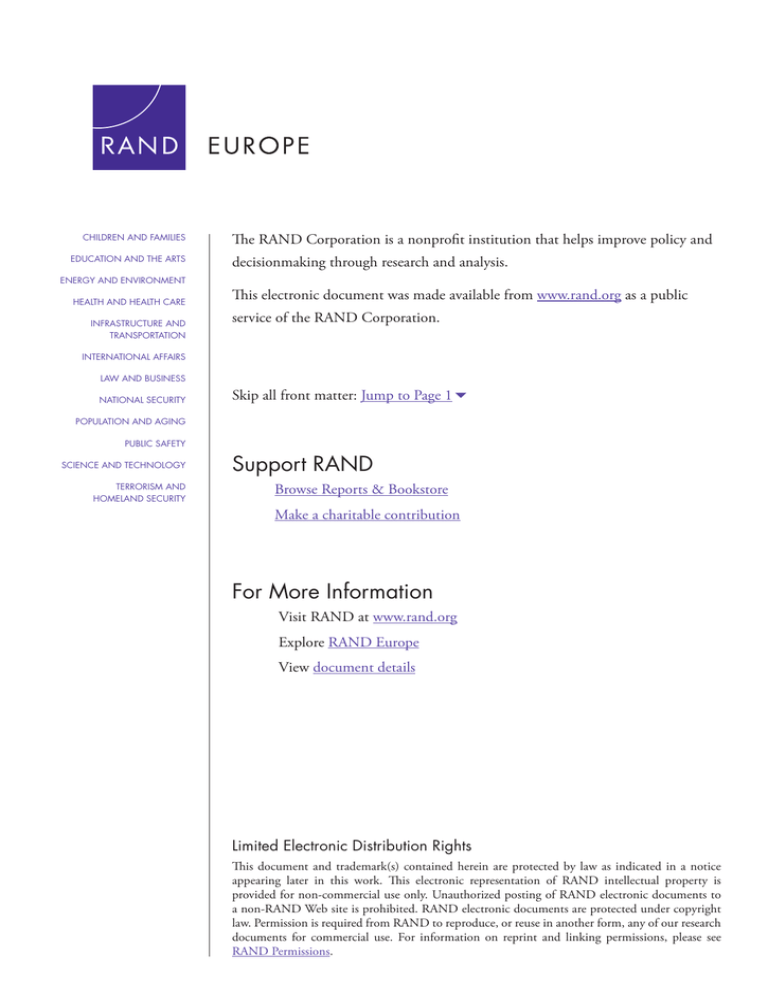The RAND Corporation is a nonprofit institution that helps improve... decisionmaking through research and analysis.
advertisement

CHILDREN AND FAMILIES EDUCATION AND THE ARTS The RAND Corporation is a nonprofit institution that helps improve policy and decisionmaking through research and analysis. ENERGY AND ENVIRONMENT HEALTH AND HEALTH CARE INFRASTRUCTURE AND TRANSPORTATION This electronic document was made available from www.rand.org as a public service of the RAND Corporation. INTERNATIONAL AFFAIRS LAW AND BUSINESS NATIONAL SECURITY Skip all front matter: Jump to Page 16 POPULATION AND AGING PUBLIC SAFETY SCIENCE AND TECHNOLOGY TERRORISM AND HOMELAND SECURITY Support RAND Browse Reports & Bookstore Make a charitable contribution For More Information Visit RAND at www.rand.org Explore RAND Europe View document details Limited Electronic Distribution Rights This document and trademark(s) contained herein are protected by law as indicated in a notice appearing later in this work. This electronic representation of RAND intellectual property is provided for non-commercial use only. Unauthorized posting of RAND electronic documents to a non-RAND Web site is prohibited. RAND electronic documents are protected under copyright law. Permission is required from RAND to reproduce, or reuse in another form, any of our research documents for commercial use. For information on reprint and linking permissions, please see RAND Permissions. This product is part of the RAND Corporation documented briefing series. RAND documented briefings are based on research briefed to a client, sponsor, or targeted audience and provide additional information on a specific topic. Although documented briefings have been peer reviewed, they are not expected to be comprehensive and may present preliminary findings. Evaluation of the peer worker programme at Cambridgeshire and Peterborough NHS Foundation Trust Alexandra Pollitt, Eleanor Winpenny, Jennifer Newbould, Claire Celia, Tom Ling, Emily Scraggs Prepared for Cambridgeshire and Peterborough NHS Foundation Trust EUROPE The research described in this document was prepared for Cambridgeshire and Peterborough NHS Foundation Trust. RAND Europe is an independent, not-for-profit research organisation whose mission is to improve policy and decision making for the public good. RAND’s publications do not necessarily reflect the opinions of its research clients and sponsors. R® is a registered trademark. © Copyright 2012 RAND Corporation Permission is given to duplicate this document for personal use only, as long as it is unaltered and complete. Copies may not be duplicated for commercial purposes. Unauthorized posting of RAND documents to a non-RAND website is prohibited. RAND documents are protected under copyright law. For information on reprint and linking permissions, please visit the RAND permissions page (http://www.rand.org/publications/ permissions.html). Published 2012 by the RAND Corporation 1776 Main Street, P.O. Box 2138, Santa Monica, CA 90407-2138 1200 South Hayes Street, Arlington, VA 22202-5050 4570 Fifth Avenue, Suite 600, Pittsburgh, PA 15213-2665 Westbrook Centre, Milton Road, Cambridge CB4 1YG, United Kingdom RAND URL: http://www.rand.org RAND Europe URL: http://www.rand.org/randeurope To order RAND documents or to obtain additional information, contact Distribution Services: Telephone: (310) 451-7002; Fax: (310) 451-6915; Email: order@rand.org Executive summary Peer workers are individuals with personal experience of mental health challenges who are employed in mainstream organisations. They support those currently receiving services and give hope of recovery. The peer worker programme at Cambridgeshire and Peterborough NHS Foundation Trust (CPFT) began training peer workers in 2010, and is now one of the longest running and largest of such initiatives in the UK. CPFT asked RAND Europe to evaluate the early stages of the programme’s implementation to establish its early impacts and set out how progress can be monitored in future. The evaluation focused on different stakeholders’ perceptions of the programme’s impact, and the successes and challenges of its implementation. We addressed these questions through interviews with people receiving services and individuals involved in programme implementation, and used focus groups to explore the views of peer workers themselves and other members of staff who work alongside them. We then worked with CPFT to develop a logic model to describe the “theory of change” underlying the peer worker programme and to identify key performance indicators for monitoring and evaluating future progress. What are the early impacts of the peer worker programme? Indications from interviews and focus groups suggested that the programme is having a positive impact on people who receive services and peer workers, with positive impacts also suggested for the teams in which peer workers are employed and the Trust more widely. Very few negative impacts were mentioned. vii What is the CPFT peer worker programme? CPFT defines a peer worker as "someone with significant experience of mental distress, who works alongside others with similar difficulties in order to facilitate recovery through promoting hope and providing support based on common experiences”. The peer worker programme began in 2010, with training initially delivered by representatives of the US organisation Recovery Innovations. Six cohorts of training have been completed to date, from which 80 peer workers have successfully graduated. As of July 2012, 37 peer workers are employed full or parttime in 42 posts within the Trust. Peer workers are employed both in inpatient and community-based teams, and the first posts in specialist services settings, such as police stations, have recently been appointed. CPFT Peer Worker Programme Evaluation RAND Europe Positive impacts were indicated for peer workers from both the training and employment. The peer worker training was seen to have a positive impact on peer workers’ own recovery. Peer workers also reported increased self esteem and confidence as a result of being in employment and felt that they had developed practical skills. A positive impact on people receiving services “In all aspects of being on the ward, the was thought to result from engagement with peer workers are really good. They'll cover peer workers. People receiving services everything, from helping you get settled considered peer workers to be approachable when you first come, to helping you feel and flexible, as well as able to provide comfortable about leaving the ward.” friendly advice, both regarding mental health challenges and practical aspects of Person receiving services care. The specific nature of a peer worker’s own mental health experience was not considered important by people receiving services. There were early indications of cultural change in peer workers’ teams and in the organisation more widely. CPFT staff reported early indications of a cultural change in some areas of the organisation, with increased focus being placed on recovery and a greater awareness of the perspective of those using services. However, it was acknowledged that this change may be a lengthy process. Beyond the peer worker programme, CPFT’s broader Recovery Strategy may also be contributing to such changes. What are the challenges in implementing the peer worker programme, and how can any challenges be addressed to further improve the programme? A number of challenges emerged from focus groups, but many of these may be consequences of the introduction of a new programme, rather than problems with the programme itself. These challenges, which are reflected more generally in the existing peer support literature, suggest four main areas to focus on: Supporting the transition of peer workers from people receiving services to employees, and supporting other staff in understanding this transition. The challenge of the movement of peer workers from receiving to delivering services was highlighted in focus groups and some staff expressed uncertainty about how to treat peer workers joining their team. “It’s difficult if you step from one side to the other… yesterday you were being discussed in a team meeting, today you’re sitting in a team meeting” Member of staff (non-peer worker) Clarifying the role of peer workers and ensuring that expectations of both peer workers and other staff are in line with the reality of the job. Peer workers and other staff commented that peer worker roles were loosely defined and varied by team. Although some flexibility is required to retain the unique benefits of peer workers, both peer workers and other staff felt that greater clarity would be useful. Providing more practical experience and ongoing support to peer workers. It was suggested that new peer workers may benefit from further practical work experience before they enter employment. Additionally, assigning a mentor when they begin work (a suggestion made by both peer workers and other staff) may assist both in helping them develop their roles and with ‘technical’ aspects of the job that may not have been covered in training. viii RAND Europe Executive summary Ensuring ongoing and timely communication “It just felt like they were going from the around the programme. Providing more passing out parade straight to the front” information on the programme’s objectives and the training could help Member of staff (non-peer worker) manage expectations of teams in which peer workers are placed, particularly regarding the roles that they expect peer workers to take on. Communication is also vital in addressing negative perceptions that may exist among some CPFT staff around issues such as the suitability or preparedness of peer workers for their roles. How do you monitor implementation and evaluate effectiveness of the peer worker programme on an ongoing basis? A logic model is a representation of how a particular programme is expected to produce results. The peer worker programme logic model was developed together with CPFT staff, and outlines the role of peer workers, setting out the activities they carry out and the inputs necessary for the programme to operate effectively. It then maps out the direct outputs of the programme and the longer term outcomes and impacts expected as a consequence of these. From the outputs, outcomes and impacts identified, we worked with CPFT to identify a range of performance indicators, and to classify these according to their importance to the programme and the feasibility of measuring them. These are illustrated in Figure 2 and provide a starting point for CPFT to build a more comprehensive picture of the programme and its impact on the various stakeholders involved. Figure 1: Key performance indicators There remain many unanswered questions regarding peer support and peer worker programmes. Some of these relate to how the peer support relationship works, while others concern the best way of organising a peer worker programme (for example, around the intensity and timing of support). As programmes such as that implemented by CPFT become more established we will become better equipped to answer such questions. ix



